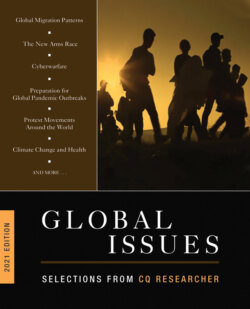Читать книгу Global Issues 2021 Edition - Группа авторов - Страница 83
At Issue
ОглавлениеIs limited nuclear war a viable battlefield option?
Yes
John D. Maurer
Jeane Kirkpatrick Fellow, American Enterprise Institute
Written for CQ Researcher, February 2020
The most viable way to prevent a limited nuclear war is to be ready to fight one. As such, the United States must modernize its arsenal of tactical or so-called low-yield nuclear weapons, whose explosive power can range from the equivalent of 20 tons of TNT to as high as a Hiroshima-sized bomb, which was 16,000 tons. Fielding such weapons will ensure that U.S. leaders have options short of all-out war to respond to nuclear provocation and will signal to adversaries that they cannot hope to escalate their way out of a losing conventional battle. By closing off options for escalation, low-yield U.S. weapons will help deter adversaries from embarking on militarized crises in the first place. Furthermore, improving and expanding U.S. low-yield capabilities will create an incentive for rivals to take seriously proposals to eliminate such weapons.
Those who oppose the United States developing tactical nuclear weapons argue that they are destabilizing because the collateral damage they cause is small enough that decision-makers might be tempted to use them in a crisis. But nuclear war is only likely to occur against the backdrop of a major conventional war between the great powers. If one of those powers fears defeat on the conventional battlefield, it will face strong pressures to use nuclear weapons to stave off that loss.
The escalatory pressure emerges not from the character of the nuclear weapons themselves, but from the looming threat of conventional military humiliation. If the losing great power has low-yield weapons that it can use without fear of reprisal, nuclear war is all but assured. Only the threat of a proportional nuclear response would deter adversaries from using such weapons to stave off defeat.
Modernizing the U.S. low-yield nuclear arsenal also provides the clearest path to eliminating tactical nuclear weapons entirely. Rivals such as Russia and China already maintain large numbers of these weapons and have no incentive to dismantle them if the United States does not have a similar capability to trade away in negotiations. Critics of low-yield nuclear weapons who are serious about eliminating their escalatory potential should support U.S. nuclear modernization as a first step toward bringing adversaries to the bargaining table.
The United States cannot abide a world in which adversaries such as Russia and China have low-yield weapons, while the United States does not. As our adversaries engage in increasingly threatening behavior toward U.S. allies, the United States needs a nuclear arsenal that will ensure deterrence—not just on good days, but also on the worst days.
NO
Joseph Cirincione
President, Ploughshares Fund
Written for CQ Researcher, February 2020
We refuse to learn from history. Almost 40 years ago, Defense Secretary Robert McNamara wrote: “It is inconceivable to me, as it has been to others who have studied the matter, that ‘limited’ nuclear wars would remain limited—any decision to use nuclear weapons would imply a high probability of the same cataclysmic consequences as a total nuclear exchange.” McNamara concluded, along with his British colleagues, that “under no circumstances” would they have recommended “that NATO initiate the use of nuclear weapons.”
But that is precisely what a new generation of Dr. Strangeloves recommends today. They have embraced the Cold War theory of “escalation dominance” and favor new, more usable nuclear weapons to fight even conventional conflicts. They argue that if the United States has greater military force on every rung of the “escalatory ladder,” it can convince an enemy to surrender early in a conflict.
But that attractive theoretical concept has little relationship to any conceivable conflict scenario, in which even a militarily inferior adversary has multiple ways of escalating a conflict. For example, the United States is militarily superior to Iran, but with a few mines and speedy patrol boats, Tehran could close the Strait of Hormuz, crippling oil flows and plunging the world economy into recession.
Yet, Iran is precisely where some in Washington favor using nuclear weapons. A 2017 Pentagon war game used U.S.-based bombers to drop a low-yield nuclear weapon on Iran. But because it would take a 10-hour flight to deliver this weapon, the Trump administration has just deployed—with congressional approval—a low-yield nuclear warhead that can be launched from submarines off Iran’s coast. This Hiroshima-sized bomb could explode within 15 minutes of launch.
Supporters justify this scenario by arguing it offers “multiple options” and “maximum flexibility,” providing military solutions to even the most difficult political problems. Most serious analysts recognized long ago that this strategy leads to disaster.
“A nuclear weapon is a nuclear weapon,” warned former Secretary of State George Shultz. “You use a small one, then you go to a bigger one.”
Iran does not have nuclear weapons, but Russia and China do. The first use of nuclear weapons against those countries would not be the last. Commanders can have no confidence that they can control or contain a limited nuclear war. Rather than being a strategy for victory, it guarantees defeat for all sides.
“We will take action, as we do in these situations,” O’Brien said. “If Kim Jong Un takes that approach, we will be extraordinarily disappointed, and we will demonstrate that disappointment.” He declined to provide any specifics but said the administration has many “tools in its tool kit” to respond to any such tests.64
Other White House officials say Trump is not looking for another confrontation with Kim in an election year. If the tests resume, they say, Trump is likely to press the United Nations to tighten sanctions against North Korea—a strategy that previous administrations have used to little effect.
Nuclear weapons experts say in the year and a half since the Singapore summit, Kim has built up his missile stores and produced enough bomb-grade nuclear fuel for about 38 warheads—double an earlier estimate issued by U.S. intelligence analysts.
